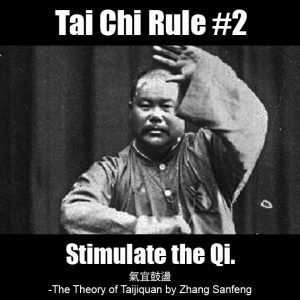The Qi should be stimulated.
氣宜鼓盪, – The Theory of Taijiquan by Zhang Sanfeng

tl;dr – Click here to skip to a simple exercise
What is Qi?
Qi means different things to different people.
It is typically translated as internal energy and there are three types of explanation.
1. It is an energy beyond western science – This can lead to training that doesn’t actually work against most people.
2. It is made up bullshit – This can lead to disregarding rewarding areas of study and limits your skill.
3. It is explained by making analogies to the nervous system, fascia, bio electricity, quantum mechanics, etc.
Unfortunately, these types of analogies don’t hold up under close scrutiny. They end up being variations on the first type of explanation cloaked in scientific or medical jargon.
So what is Qi?
It is a feeling.
When we use the mind and body in specific ways there is a physical sensation in the body. We are going to call that sensation Qi.
Much of Taijiquan training is about using the mind to make subtle yet powerful changes inside the body.
To do this we need to feel inside the body and we need to label these feelings. This gives us an internal reference point as we work on improving our skill. It also gives us a language we can use to impart these skills to others.
Once someone can feel and reproduce this sensation, we can simply say “expand, contract, sink or spiral the Qi” and they instantly know how to work on any number of important Taiji skills. And they know what it feels like when those skills are done correctly.
In Taijiquan we are going to talk about energy a lot, along with many other similar concepts. We are going to talk about them as if they are physical things interacting with the body because that’s how it should feel.
It is important to remember that this language is describing what it feels like to connect the body and mind and use them in specific ways. It is not describing the actual physiological processes that are taking place.
So what does Qi feel like?
Unfortunately it’s not a simple “Qi feels like X.” Otherwise we could simple use that word instead.
Warmth, slight pressure, a tingle like electricity or vibration. It may have a magnetic push or pull to it.
These sensations will be very slight and subtle at first.
Most beginning qigong exercises should begin to help you get a feeling for Qi. If you don’t have some already you can use the one below.
tl;dr – Qi is a physical sensation that lets you know if you’re doing it right.
What does it mean to stimulate the Qi?
This passage has been translated as: excited, stirred, full & stimulated, extended and vibrated like a drum. The characters in question also have connotations of: to move, to beat, to shake, to agitate, rouse.
There is some ambiguity here and different schools of Taijiquan will have slightly different versions of this quality.
You know the qi is stimulated when it feels full and flowing throughout the entire body.
The flushed energized feeling you get after a vigorous physical warm up is a version of this.
How to Stimulate the Qi
The light and agile drills will help stimulate the qi.
A quick and crude method is to slap and shake the body the way athletes do before vigorous competition.
In fact any warm up exercise that gets the blood flowing and makes you relaxed and energized will do as long as you remain calm and focused. We’ll cover why you must be calm in Rule #3.
Once you achieve this feeling make sure to maintain it during your Tai Chi practice session.
Once you get good at stimulating the Qi, work on reducing the amount of time it takes you to achieve this state. Your goal is to produce this state almost instantly using mental focus more than physical activity.